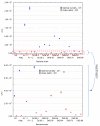Effects of Rhizosphere Bacteria on Strawberry Plants (Fragaria × ananassa Duch.) under Water Deficit
- PMID: 36142361
- PMCID: PMC9499335
- DOI: 10.3390/ijms231810449
Effects of Rhizosphere Bacteria on Strawberry Plants (Fragaria × ananassa Duch.) under Water Deficit
Abstract
Due to the observed climate warming, water deficiency in soil is currently one of the most important stressors limiting the size and quality of plant crops. Drought stress causes a number of morphological, physiological, and biochemical changes in plants, limiting their growth, development, and yield. Innovative methods of inducing resistance and protecting plants against stressors include the inoculation of crops with beneficial microorganisms isolated from the rhizosphere of the plant species to which they are to be applied. The aim of the present study was to evaluate 12 different strains of rhizosphere bacteria of the genera Pantoea, Bacillus, Azotobacter, and Pseudomonas by using them to inoculate strawberry plants and assessing their impact on mitigating the negative effects of drought stress. Bacterial populations were assessed by estimates of their size based on bacterial counts in the growth substrate and with bioassays for plant growth-promoting traits. The physiological condition of strawberry plants was determined based on the parameters of chlorophyll fluorescence. The usefulness of the test methods used to assess the influence of plant inoculation with rhizosphere bacteria on the response of plants growing under water deficit was also evaluated. A two-factor experiment was performed in a complete randomization design. The first experimental factor was the inoculation of plant roots with rhizosphere bacteria. The second experimental factor was the different moisture content of the growth substrate. The water potential was maintained at -10 to -15 kPa under control conditions, and at -40 to -45 kPa under the conditions of water deficit in the substrate. The tests on strawberry plants showed that the highest sensitivity to water deficiency, and thus the greatest usefulness for characterizing water stress, was demonstrated by the following indices of chlorophyll "a" fluorescence: FM, FV, FV/FM, PI, and Area. Based on the assessment of the condition of the photosynthetic apparatus and the analysis of chlorophyll "a" fluorescence indices, including hierarchical cluster analysis, the following strains of rhizosphere bacteria were found to have favorable effects on strawberry plants under water deficit: the Bacillus sp. strains DLGB2 and DKB26 and the Pantoea sp. strains DKB63, DKB70, DKB68, DKB64, and DKB65. In the tests, these strains of Bacillus sp. exhibited a common trait-the ability to produce siderophores, while those of Pantoea sp. were notable for phosphate mobilization and ACCD activity.
Keywords: PGPR; bacterial counts; drought stress; fluorescence of chlorophyll “a”; strawberry.
Conflict of interest statement
The authors declare no conflict of interest.
Figures












References
-
- Hura T., Grzesiak S., Hura K., Thiemt E., Tokarz K., Wȩdzony M. Physiological and biological tools useful in drought-tolerance detection in genotypes of winter triticale: Accumulation of ferulic acid correlates with drought tolerance. Ann. Bot. 2007;100:767. doi: 10.1093/aob/mcm162. - DOI - PMC - PubMed
-
- Kalaji M.H., Pietkiewicz S. Some physiological indices to be exploited as a crucial tool in plant breeding. Plant Breed. Seed Sci. 2004;49:19–39.
MeSH terms
Substances
LinkOut - more resources
Full Text Sources
Research Materials
Miscellaneous

